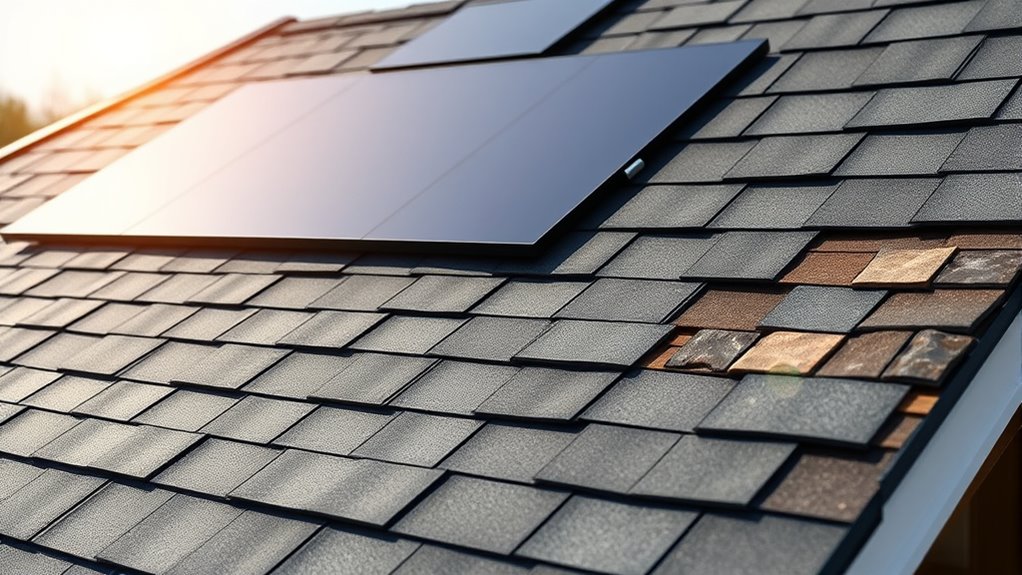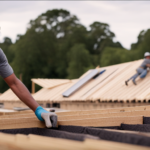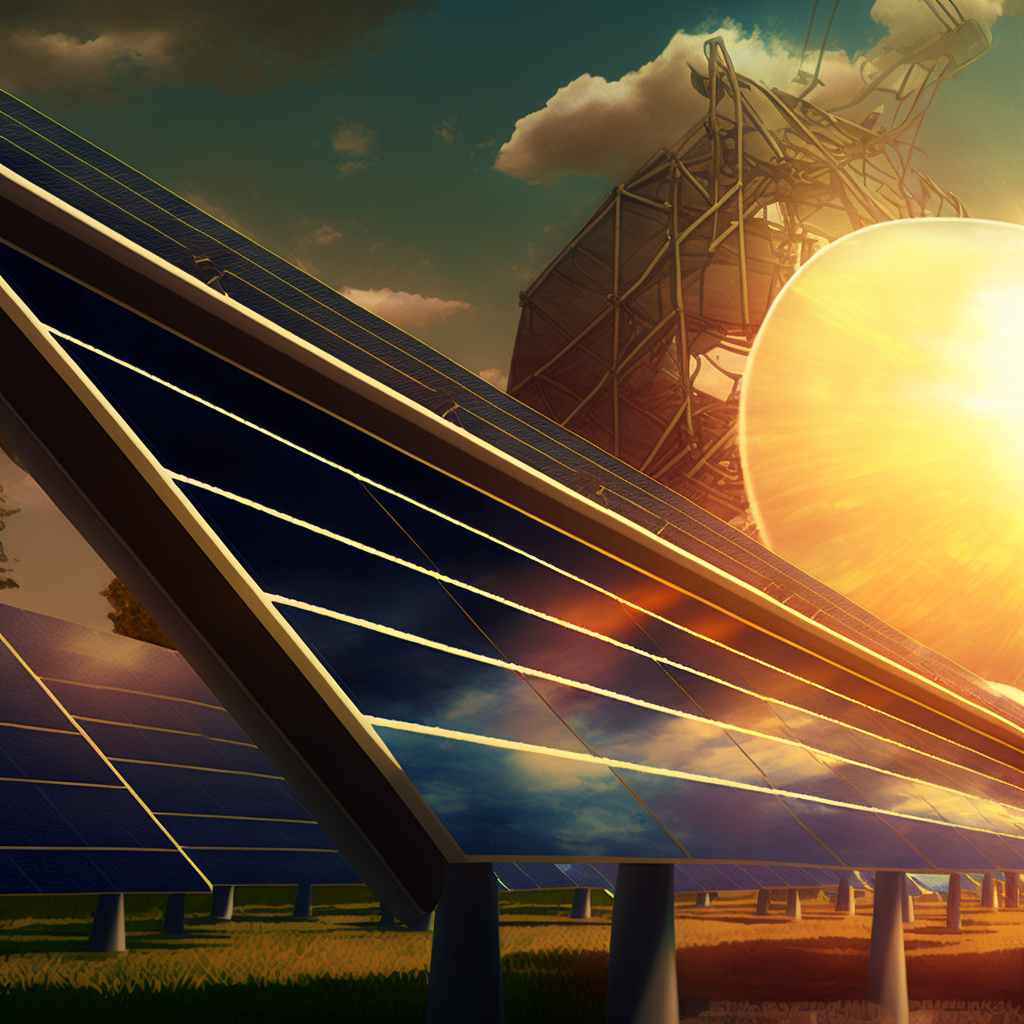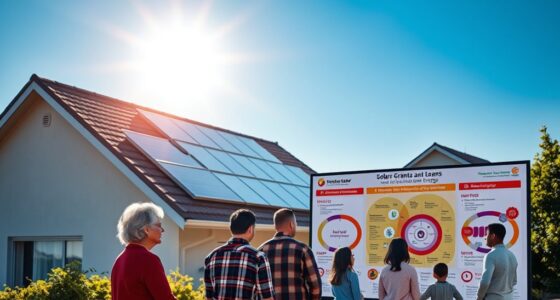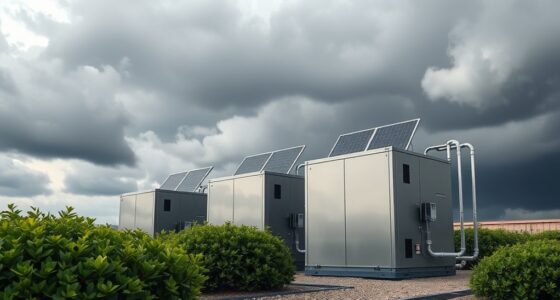Installing solar shingles can cost between $42,000 and $50,000 for a retrofit, while a new roof installation might be more upfront but offers better support and higher energy output. Retrofit costs depend on your roof’s size, shape, and condition, whereas new roofs can be optimized for solar integration. Since costs vary and incentives are available, understanding the differences helps you make smarter choices—continue on to explore more about options and savings.
Key Takeaways
- New roof installations typically cost more upfront but offer better integration, durability, and energy efficiency compared to retrofitting.
- Retrofitting may reduce initial costs but can face structural challenges and limited energy output due to existing roof conditions.
- Installing solar shingles on a new roof allows for optimal framing, support, and seamless aesthetics, often resulting in long-term savings.
- Retrofitting often involves additional modifications, increasing labor and material costs, especially on complex or older roofs.
- Overall, new roof installations usually provide higher energy output and property value benefits over retrofit solar shingle setups.
Cost Overview of Solar Shingle Retrofit and New Roof Installations
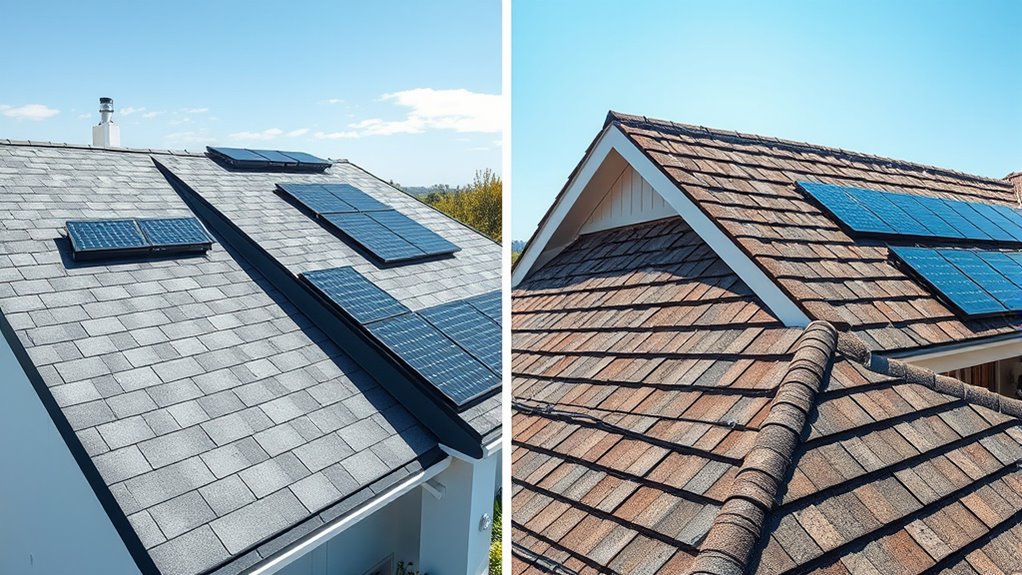
Installing solar shingles involves a significant upfront investment that varies depending on whether you’re retrofitting an existing roof or installing on a new one. For a 2,000-square-foot roof, expect costs between $42,000 and $50,000. The installation typically ranges from $21 to $25 per square foot, including labor. Solar shingles cost about $5.00 to $7.00 per watt, which is higher than traditional solar panels. Retrofitting can be more expensive and complex because of existing roof conditions, possibly requiring additional supports or modifications. On the other hand, installing on a new roof, especially as part of a full replacement, can be bundled with the cost of the roof itself. The installation process for solar shingles can be more intricate than traditional panels, often requiring specialized skills. Overall, these costs are significant but can be offset by incentives like tax credits and rebates.
Factors That Affect Installation Expenses
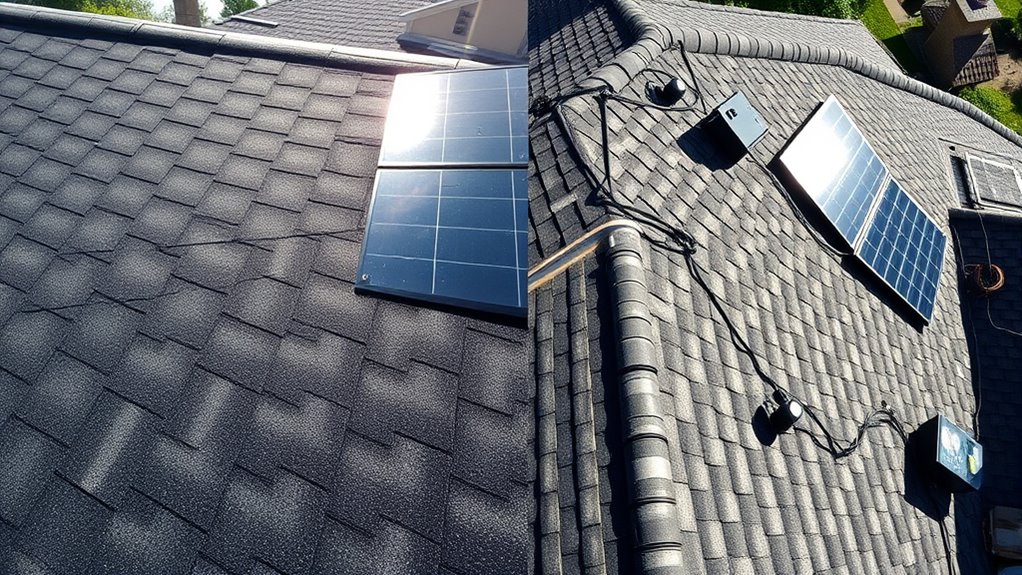
Your installation costs depend heavily on your roof’s size and slope, which influence the amount of coverage and labor needed. Regional labor rates also affect overall expenses, with higher wages increasing the price. Additionally, choosing premium materials and trusted brands can raise costs but may offer better durability and efficiency. Larger roofs lead to higher total costs, and complex roof shapes may require additional work, further increasing expenses.
Roof Size & Slope
Roof size and slope are key factors that influence the overall cost of solar shingle installations. Larger roofs require more shingles, raising material costs, with prices ranging from $21 to $40 per square foot depending on complexity. For example, a typical 1,700 sq. ft. roof might cost between $25,000 and $60,000. Full coverage increases costs considerably, while partial coverage reduces expenses. Steeper slopes add to labor difficulty, requiring extra safety measures and specialized mounting, which boosts installation costs. Complex roof shapes, valleys, or irregular layouts also prolong installation and increase waste. Additionally, larger or steeper roofs demand more wattage capacity, raising the number of shingles needed and overall expenses. Proper assessment of size and slope is essential to accurately budget your solar shingle project. Regional cost variations can also influence overall expenses, as local labor and material prices fluctuate, and understanding roof design complexities helps in accurate planning.
Regional Labor Costs
Regional labor costs play a significant role in determining the total expense of solar shingle installations. Urban areas typically have higher rates due to the cost of living, while rural regions tend to be more affordable. Skilled labor availability impacts pricing; regions with more certified technicians often see increased competition and lower rates. Electricians charge between $50 and $130 per hour, affecting overall costs. Steep roofs require extra safety measures, raising labor expenses. Here’s a quick overview:
| Area Type | Typical Cost Factors | Impact on Installation |
|---|---|---|
| Urban | Higher wages, cost of living | Increased costs |
| Rural | Lower wages, less competition | More affordable |
| Skilled Techs | Availability & competition | Price variation |
Understanding these regional differences helps you anticipate costs better. Additionally, regional economic factors can influence the overall labor market and pricing trends in your area. Being aware of labor market dynamics can help you plan your project more effectively.
Material Quality & Brand
Material quality and brand reputation are key factors that influence the overall cost of installing solar shingles. Higher-quality materials typically cost more but offer better durability and performance, which can save money in the long run. Brand reputation also impacts price; premium brands like Tesla and CertainTeed charge more for their proven quality and warranties. When choosing materials, consider:
- Cost Variability: Prices range from $5.50 to $7 per watt, depending on quality.
- Brand Influence: Premium brands like Tesla can cost $6.5 to $13 per watt.
- Integration Complexity: High-quality shingles often require specialized installation, increasing costs.
Opting for top-tier brands usually means higher upfront costs but better longevity and support, making it a vital factor in your overall project budget.
Comparing Long-Term Savings and Energy Output
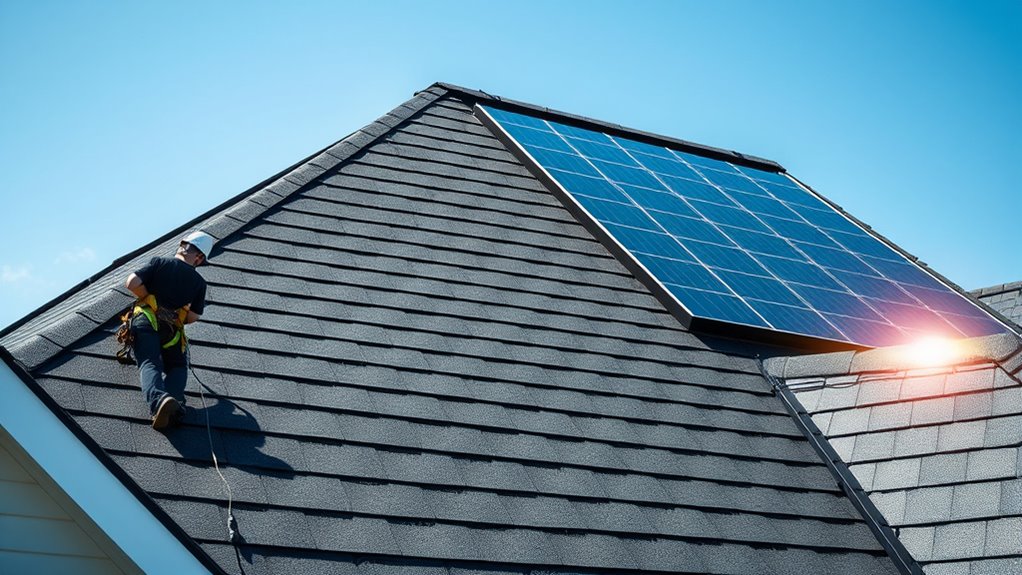
When comparing long-term savings and energy output between retrofit and new roof solar shingle installations, it’s important to contemplate both initial costs and efficiency. Retrofit systems cost less upfront but may produce less energy due to suboptimal placement or shading, affecting overall savings. Energy savings typically take 12-16 years to realize, aided by tax credits and rebates. However, new roof installations, though more expensive initially, often yield higher energy output because of ideal placement and integrated design, leading to potentially greater long-term savings. Efficiency differences mean retrofit systems might generate less power, impacting payback periods. While new roof solar shingles cost more per watt, their superior integration can improve energy output and home value, ultimately influencing your long-term financial benefits.
Advantages of Installing Solar Shingles on New Roofs
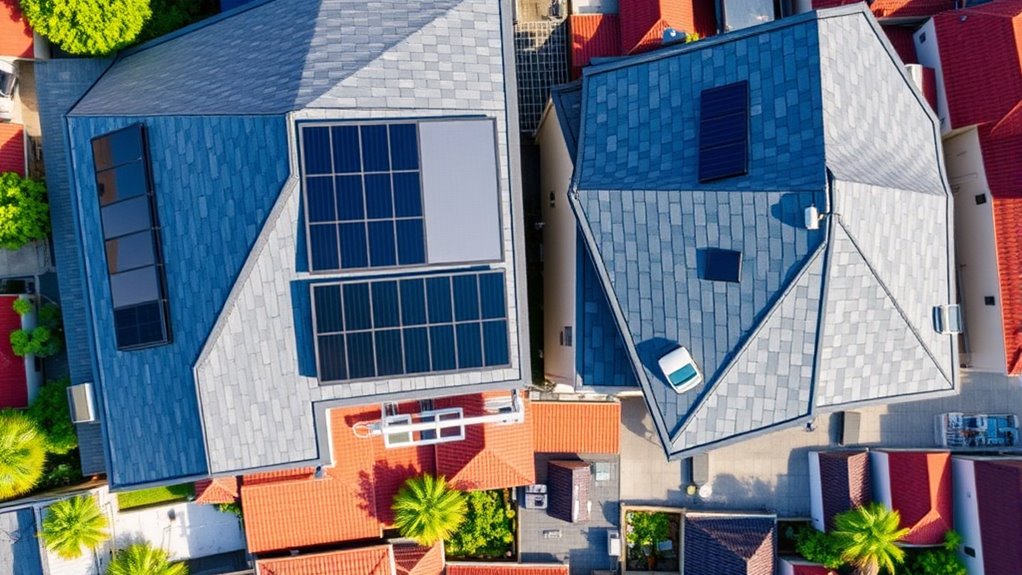
Installing solar shingles on a new roof offers a sleek, integrated look that enhances your home’s curb appeal. The added support from a new roof guarantees greater durability and protection for your solar system, reducing future maintenance costs. Plus, combining roof replacement with solar installation streamlines the process and can save you money in the long run.
Seamless Integration Benefits
Seamless integration of solar shingles with your roof design offers a sleek, visually appealing solution that enhances curb appeal. Because they mimic traditional roofing materials, solar shingles blend naturally with your roof, maintaining architectural integrity. They’re especially suited for complex rooflines like curved or hipped designs, making installation easier and less disruptive. Plus, they preserve the symmetry and historic charm of neighborhoods or HOA communities. Solar shingles available commercially since 2005 and continue to evolve, ensuring high-quality options for homeowners. Additionally, weather resistance is improved, providing waterproof protection and durability against storms, which is crucial for long-term performance.
- Achieve a unified look that boosts curb appeal and avoids bulky panel appearances
- Simplify installation with conventional roofing tools, reducing time and labor
- Strengthen weather resistance, offering waterproof protection and durability against storms
This integration results in a cleaner, more attractive roof while delivering reliable, long-lasting energy benefits.
Structural Support Advantages
Choosing to incorporate solar shingles into a new roof offers significant structural support advantages. Solar shingles are built with durable materials that withstand extreme weather, like hurricanes and hail, boosting overall roof resilience. Their integrated design replaces traditional materials, creating a uniform protective layer without extra mounting hardware that could weaken the structure. Installing during new construction allows for ideal framing, tailored support, and better load distribution, reducing stress on the roof’s framework. This setup minimizes structural modifications, such as drilling or reinforcement, which are common in retrofits. Additionally, new roofs can be built with advanced materials and framing techniques designed specifically for solar shingles, enhancing overall support and durability from the start. Integrating solar shingles during construction can also improve the overall lifespan of the roofing system by ensuring optimal installation conditions from the outset, and leveraging modern construction methods can further optimize the structural benefits.
Enhanced Aesthetic Appeal
When you opt for solar shingles on a new roof, their integrated design creates a sleek and uniform appearance that enhances your home’s overall look. They blend seamlessly with traditional roofing materials, providing a discreet and stylish alternative to bulky solar panels. With various style options mimicking asphalt or slate, solar shingles can match your home’s aesthetic and meet community standards, even in strict HOA areas. Installing them can boost your home’s curb appeal and potentially increase its property value.
- Design Integration: Seamlessly blends with existing roofing materials
- Visual Impact: Discreet and less obtrusive than traditional panels
- Style Variations: Mimics common roofing materials for a cohesive look
Challenges and Considerations for Retrofitting Solar Shingles
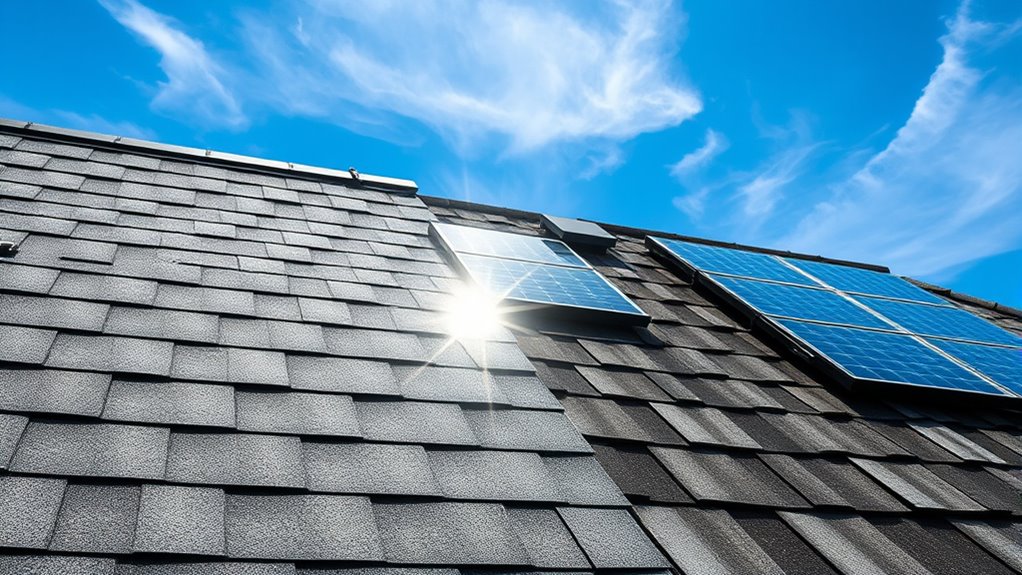
Retrofitting solar shingles presents several challenges that homeowners and contractors must carefully consider. One major factor is structural compatibility. Solar shingles add weight, which can strain older roofs, especially tile types, requiring load assessments and possible reinforcement. The condition of your roof is critical; if it’s aging or damaged, it may need replacement before installation. Proper load distribution is essential to prevent damage to the roof deck or tiles. Installation complexity also poses hurdles, as removing and replacing existing tiles is labor-intensive and costly. Permitting and building code compliance can cause delays. Roof type matters too—tile roofs need careful handling to avoid damage, and roof pitch or shading can impact energy production. These considerations make retrofitting a careful process, demanding professional expertise for safety and efficiency. Proper assessment of roof integrity is vital to ensure that the structure can support the additional load and installation process. Additionally, understanding cultural perspectives on new technology adoption can influence homeowner decisions and expectations.
Financial Incentives and Their Impact on Overall Costs

Financial incentives play a crucial role in reducing the overall costs of solar shingle installations, making them more accessible and financially attractive. The federal solar tax credit offers a 30% deduction on installation costs in 2025, directly lowering your expenses. State and local incentives, like Arizona’s 25% income tax credit up to $1,000, further cut costs. Additionally, if the tax credit exceeds your liability, you can carry it over to future years, maximizing benefits. These incentives not only reduce upfront costs but also encourage market demand, which can lead to lower prices over time. The 2025 tax credit policies significantly increase the affordability of solar projects. – Federal and state incentives can cut costs by 30% or more. – Tax credits improve cash flow through deductions. – Increased demand may lower installation prices. Understanding the impact of incentives on project affordability can help homeowners make informed decisions.
Frequently Asked Questions
How Does Roof Age Influence Retrofit Solar Shingle Costs?
Roof age directly impacts retrofit solar shingle costs because older roofs often need repairs, reinforcement, or even replacement before installation. You might face higher labor costs due to irregularities, damage, or complex angles. Additionally, the need for specialized waterproofing and inspections can increase expenses. If your roof’s lifespan is limited, replacing it first can be more economical, ensuring your solar shingles last longer and perform better.
Are There Specific Roofing Materials Better Suited for Retrofit Solar Shingles?
When it comes to retrofit solar shingles, you want to play it smart and pick the right roofing material. Metal roofs are a top choice because they’re durable and compatible, making installation smoother. Asphalt and composite shingles work well too, especially if they’re in good shape, but tile roofs can be trickier. Overall, selecting a material with a solid foundation helps ensure your solar upgrade pays off in the long run.
What Is the Typical Lifespan Comparison Between Retrofit and New Roof Solar Shingles?
You ask about the lifespan comparison between retrofit and new roof solar shingles. Both options typically last around 25 to 30 years, so their longevity is quite similar. The main difference lies in installation factors—new roofs often offer better structural support from the start, while retrofits depend on existing roof conditions. However, in regarding durability and energy output over time, they perform comparably, maintaining protection and functionality throughout their lifespan.
Can Solar Shingles Be Easily Removed or Transferred if I Sell My Home?
When you think about selling your home with solar shingles, imagine passing on a built-in feature rather than a removable accessory. Removing them isn’t straightforward—you’d face potential roof damage and costly repairs, making disassembly impractical. Generally, solar shingles stay with the house, transferring ownership seamlessly if fully paid off. If leased or financed, you’ll need proper transfer arrangements. Most often, leaving them on benefits both seller and buyer, simplifying the sale process.
How Do Local Climate Conditions Affect Solar Shingle Performance and Costs?
Your local climate notably impacts how well solar shingles perform and their costs. Hot regions can cause efficiency drops due to heat, but proper ventilation helps. Cloudy areas need larger or advanced systems to compensate for reduced sunlight, increasing upfront costs. Snowy environments may reduce winter output temporarily but benefit from easier snow shedding. Rain cleans the shingles, boosting efficiency, with minimal cost effects. Overall, climate influences installation needs and long-term savings.
Conclusion
Whether you’re adding solar shingles to a new roof or retrofitting an old one, remember, you’re shaping your home’s future like an artist crafting a masterpiece. While costs may seem intimidating, the promise of energy savings and sustainability is a shining beacon guiding your decision. Embrace the journey, knowing each shingle is a brushstroke toward a greener, brighter tomorrow. Your choice today fuels a legacy of innovation and hope.
I’m Theodore, and I love tiny houses. In fact, I’m the author of Tiny House 43, a book about tiny houses that are also tree houses. I think they’re magical places where imaginations can run wild and adventures are just waiting to happen.
While tree houses are often associated with childhood, they can be the perfect adult retreat. They offer a cozy space to relax and unwind, surrounded by nature. And since they’re typically built on stilts or raised platforms, they offer stunning views that traditional homes simply can’t match.
If you’re looking for a unique and romantic getaway, a tree house tiny house might just be the perfect option.
